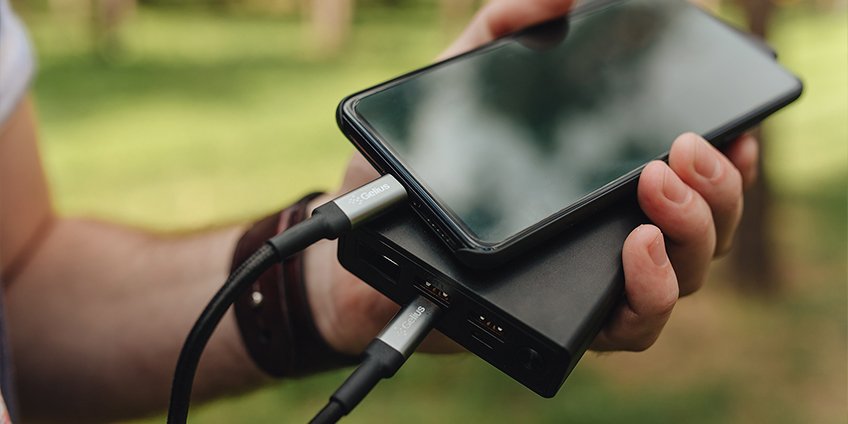How to determine the real capacity of a power bank?
Menu
- What is the actual battery capacity
- Methods for determining real capacity
- Factors affecting measurement accuracy
- Recommendations for determining actual capacity
- Frequently asked questions about actual capacity
- Conclusion
When choosing a power bank, you need to evaluate its battery capacity, the availability of fast charging and compatibility with devices. These factors will help you choose the best option for charging your smartphone, headphones, tablets and other gadgets. Determining the efficiency of an external battery is often associated with studying its functionality and characteristics, including actual capacity.
ROM battery capacity is a quantity measured in milliamp-hours (mAh) that determines how much electrical energy the device can store. Knowing the indicators is important for understanding how many times you can charge your gadgets using a specific Power Bank. The higher the capacity, the more charges it can provide.
This information is especially useful when choosing a device, taking into account the user's charging needs throughout the day. Based on it, you can determine how long an additional battery can provide energy to smart gadgets in the absence of access to the power grid.
What is the actual battery capacity?
The real battery capacity of a power bank represents the actual ability of the device to store electrical energy and transmit it to connected devices. This parameter may differ from the nominal value indicated by the manufacturer.
The rated capacity is a theoretical value determined by the manufacturer and represents the maximum amount of energy that a battery can theoretically contain. The real one takes into account energy losses arising from various factors, such as the internal resistance of the battery, temperature conditions, degree of wear and others.
Knowing the actual capacity is important because it provides more accurate information about how much power can actually be transferred to gadgets when using ROM. The difference between nominal and real indicators allows a more realistic assessment of the efficiency of an external battery under real operating conditions.

Methods for determining real capacity
When determining the actual battery capacity, various methods are used, each of which has its own advantages and disadvantages:
✔️ Using chargers
This method has its advantages:
- Ease of use.
- Ability to estimate battery capacity by measuring charging and discharging times.
Disadvantages of this method:
- Not always accurate results due to possible energy losses during the charging and discharging process.
- Does not provide accurate digital data.
✔️ Using the software
The advantages of the method include:
- Allows you to obtain more accurate digital indicators.
- Can provide additional information about the condition of the battery.
Of the minuses:
- Requires specialized software and additional hardware.
- Not always available for all battery types.
✔️ Using a multimeter
Pros:
- Provides high measurement accuracy.
- Suitable for various types of batteries.
Minuses:
- Requires certain skills and knowledge for correct application.
- Not always convenient for mass use due to complexity and time consumption.
Note. The choice of method for determining the actual battery capacity depends on the specific needs and capabilities of the user, as well as the available equipment and level of technical awareness.

Factors affecting measurement accuracy
When measuring the actual battery capacity of a portable charger, there are several key factors to consider that can affect the accuracy of the results.
☑️ Temperature conditions
Impact: Ambient temperature has a significant impact on the chemical processes inside the battery. High or low temperatures can distort measurements, resulting in inaccurate data.
Recommendations: Measurements should be carried out at room temperature to obtain more stable results.
☑️ Battery age and condition
Impact: Over time, batteries are subject to wear and tear, which can reduce their capacity. Also, the condition of the battery (healthy or degraded) affects the accuracy of measurements.
Recommendations: If necessary, adjust measurements taking into account the age and condition of the battery.
☑️ Battery type and manufacturer
Impact: Different types of batteries (li-ion, lithium polymer) may have different structures and chemical characteristics, affecting the accuracy of the measurement. Also, workmanship and brand can affect the characteristics of the battery.
Recommendations: Consider the type and manufacturer when analyzing measurement results.
The note. Studying and taking into account these factors will help to obtain more reliable data on the real capacity of the power bank, which is important for the effective use and maintenance of the longevity of the ROM.

Recommendations for determining actual capacity
To independently measure the actual capacity of a portable charger, you should study the recommendations, paying attention to the preparation of the mobile accessory and the charging equipment used:
1️⃣ Preparing the device
- Discharging the device. For more accurate results, you must ensure that the ROM battery is completely discharged before starting testing.
- Give the power bank a rest. After discharging the device and then starting charging, you need to give it a rest to cool completely.
2️⃣ Charging equipment
- Choose only high-quality blocks and cables. To avoid possible distortion of the results, original and certified chargers should be used.
- Connect the charger to the power source. Make sure the power supply is stable to avoid voltage surges affecting the accuracy of the measurements.
3️⃣ Measurement
- Connect the power bank to the mains charger to ensure a reliable and stable connection.
- Start the Power Bank charging process following the manufacturer's instructions.
- Carefully monitor the charging process, recording changes in voltage and capacity.
- Complete charging by fully charging the portable charger to 100%.
- Write down the results obtained: voltage and battery capacity of the power bank. Calculate the change in indicators during charging.
- Analyze the results. Compare starting and ending data. Evaluate how well the results correspond to the stated characteristics of the portable charger.
The note. Following these steps and recommendations will provide a more accurate determination of the actual capacity of the ROM, which is important for proper use and maintenance of its effectiveness.

Frequently asked questions about actual capacity
1. What is the actual battery capacity?
Real battery capacity is the actual capacity available for use when charging the external battery.
2. What is the difference between rated and actual capacity?
The rated capacity is indicated by the manufacturer and represents a theoretical value, while the real one takes into account actual losses and operating conditions.
3. Why is it important to know the real capacity?
Knowing the actual capacity helps you evaluate the actual charging capabilities of your device, avoiding the disappointment of insufficient capacity.
4. Does temperature affect the actual capacity?
Temperature conditions can affect battery performance, so it is recommended to measure capacity under normal temperature conditions.
5. Can the actual capacity decrease over time?
Factors such as aging and misuse can reduce the battery's actual capacity.
6. How often is it recommended to measure the actual battery capacity?
It is recommended to carry out measurements periodically, especially if there are noticeable changes in ROM performance or during prolonged use.

Conclusion
Correct determination of the actual capacity plays a key role in ensuring the efficient and smooth functioning of power banks. Knowing the actual capacity helps users realistically estimate how many times they can charge their device before the power bank itself requires charging. Understanding this also prevents frustration from having insufficient energy reserves during critical times such as travel, emergencies, or lack of access to a power source.
In general, correctly determining the actual battery capacity of a power bank is a fundamental step to ensure the efficiency and reliability of external batteries, which in turn contributes to the comfortable use of electronic devices in everyday life.